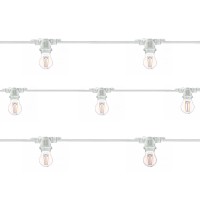Lighting is a fundamental element for the comfort and functionality of any home or work environment. Therefore, understanding how much light is needed in a room can improve not only the aesthetics, but also the liveability of the spaces.
For this reason we recommend that you continue reading this article, because you will discover how to calculate the ideal amount of light for each context, what lumens and watts are, how to choose the LED bulbs best suited to your needs and much more.
Why is it important to calculate the necessary light?
A well-lit room improves well-being, concentration and safety. For example, a kitchen with insufficient light may make it difficult to prepare food safely, while an overlit living room may be less welcoming.
Furthermore, accurately calculating the necessary light allows you to avoid energy waste, reducing bill costs and environmental impact.
Watts and Lumens: what's the difference?
Traditionally, we have been used to measuring lighting in watts, but with the advent of LED technology, this unit is no longer a reliable indicator of the amount of light emitted. Let's see the difference:
Watts (W): Indicate the amount of energy consumed by the bulb. With traditional (incandescent) light bulbs, a higher number of watts corresponded to a brighter light. With LEDs, however, bulbs that consume fewer watts can emit a much stronger light.
Lumens (lm): Represent the amount of light emitted by a bulb. It is the unit of measurement that we must consider today to choose the ideal lighting level for each room. For example, an old 60W incandescent bulb produced around 800 lumens, while a mere 8-10W LED bulb can produce the same amount of light.
Do you want to know the difference between Lux and Lumen? Read this article!
How much light do you need in each room?
The amount of light needed varies based on the function of the room and the activities taking place there and is measured in lumens per square meter (lux). Below is a guide to the lighting needs of the main areas of the house:
1. Kitchen: Recommended light: 300-400 lux for general lighting and 500-700 lux for work areas such as the countertop or island. Reason: The kitchen is an operational area that requires uniform and bright light to ensure precision and safety.
2. Living room: Recommended light: 100-300 lux. Reason: It must be a relaxing but versatile environment. Combine soft light for moments of relaxation with directional lights for reading or highlighting decorative elements.
3. Bedroom: Recommended light: 100-200 lux for general lighting and 300 lux for reading lights next to the bed. Reason: The atmosphere must be calm and relaxing, with more intense light points for specific activities.
4. Bathroom: Recommended light: 300-500 lux. Reason: The light must be clear and without shadows, especially around the mirror, to facilitate personal care.
5. Office or study: Recommended light: 500-750 lux. Reason: To avoid eye strain and improve productivity, bright, even lighting on your desk is essential.
6. Corridors and entrances: Recommended light: 100-200 lux. Reason: Sufficient lighting is needed to ensure safety and orientation, but without excess.
Lumen-Watt conversion table for LED lighting
With LEDs, knowing how many lumens a bulb produces compared to the watts consumed helps you choose the right light and save energy. Here is an indicative table:
|
Lumen |
Incandescence (W) |
LED (W) |
|
250 |
25 |
3-4 |
|
450 |
40 |
4-5 |
|
800 |
60 |
8-10 |
|
1100 |
75 |
10-13 |
|
1600 |
100 |
13-17 |
|
2600 |
150 |
25-28 |
For example, if you need to illuminate a 20m2 living room with 150 lux, you will need around 3000 total lumens. With an 800 lumen LED bulb, you could use four bulbs to get the lighting you want.
How to calculate the necessary light
1. Calculate the square meters of the room: Multiply the length by the width. Example: A 4x5 m room has a surface area of 20 m2.
2. Multiply by the required lux level: Use the table above to find your ideal value. Example: For a living room, 20 m2 x 150 lux = 3000 lumens.
3. Choose the right LED bulbs: Divide the total lumens by the number of bulbs you want to install. Example: With 3000 lumens needed, you can use 4 800 lumen bulbs or 3 1000 lumen bulbs.
In conclusion, knowing how much light is needed in a room is essential for creating functional, welcoming and sustainable environments. In addition to this, knowing the difference between watts and lumens and how to convert the values allows you to choose efficient LED bulbs suitable for every space.
So remember to consider the use of the room, interior design and personal needs when planning your lighting. A well-lit home not only improves the quality of life, but also reduces environmental impact.
Now all you have to do is choose the right lamp for your space,
you can find lots of them on our Diffusione Luce website!
Written by Alice Pruccoli





































